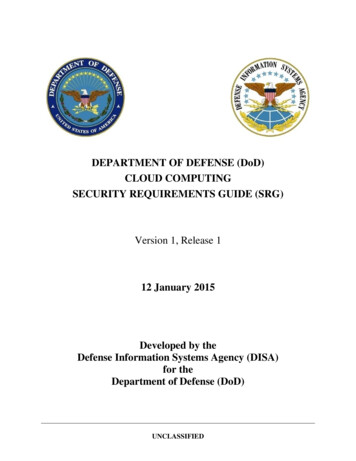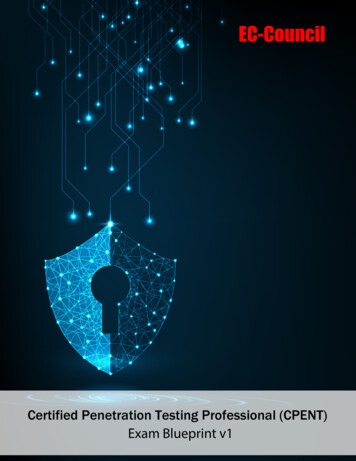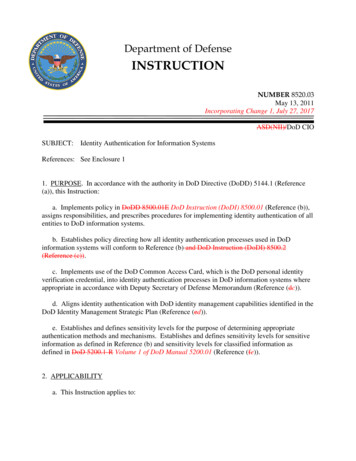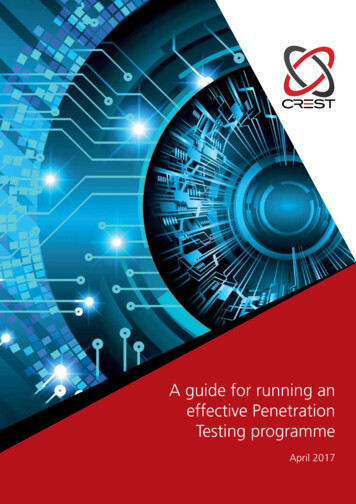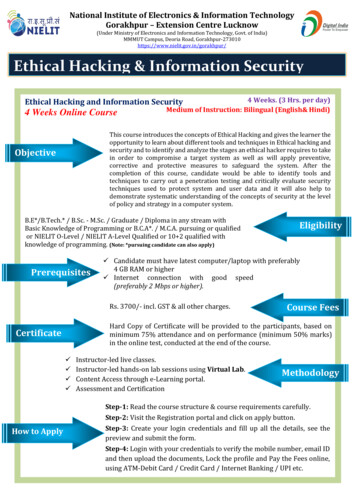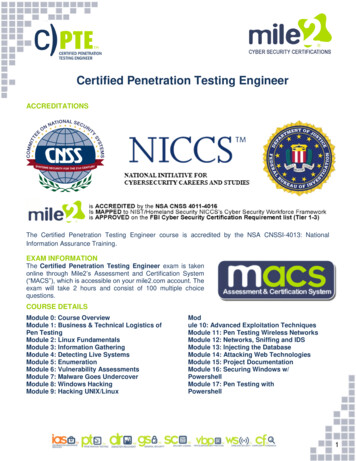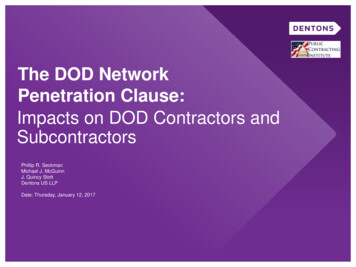
Transcription
The DOD NetworkPenetration Clause:Impacts on DOD Contractors andSubcontractorsPhillip R. SeckmanMichael J. McGuinnJ. Quincy StottDentons US LLPDate: Thursday, January 12, 2017
Agenda Cyber threats Regulatory landscape DOD's covered defense information (CDI) final rule History Requirements Issues Supply chain compliance Compliance and breach response final considerations2
Cyber Attacks: An Ever-Growing Threat Most recent high-profile breach: 19,000 emails from the DNC leaked Yahoo breach: state-sponsored actor stole data associated with 500million user accounts—one of the largest cybersecurity breaches ever GAO: Cyber incidents affecting federal agencies increased 1,300percent from FY 2006 to FY 2015 77,183 incidents in 2015 Attacks are top concern of FBI and intelligence community Cyber attacks focused on IP, critical infrastructure, and personal data Mandiant Report: APT1 in China responsible for estimated 80-90% of cyberincidents involving classified information, trade secrets, IP3
Regulatory Landscape Contractors faced with patchwork of legal requirements Federal Information Security Management Act of 2002 Primarily applicable to government information systems, but also to contractors Federal Information Security Modernization Act of 2014 Signed into law on Dec. 18, 2014 New requirements likely forthcoming regarding reporting of major incidents andagency breaches Industry- / agency-specific requirements (e.g., DOD, NASA, GSA, DOE) SEC disclosures for material cyber incidents HIPAA requirements FTC treatment of breaches as unfair trade practices State-specific breach notification laws International requirements Private sector requirements (e.g., PCI DSS)4
Unclassified Controlled Technical Information(UCTI) Clause Issued on Nov. 18, 2013 (78 Fed. Reg. 69,273) Established new contract clause: DFARS 252.204-7012 Included clause in all DOD contracts issued after Nov. 18, 2013 Applies to small business and commercial item contracts Applies to any contractor information system that "may have" UCTI resident onor transiting through it UCTI "Technical Information" Technical data or computer software "Controlled" Technical Information Military or space application Subject to controls on access, use, modification, release Marked with required distribution statement pursuant to DOD Instruction 5230.24,Distribution Statements on Technical Documents5
UCTI Clause Requirements Safeguarding requirements: Compliance with 50 security controls from NIST SP 800-53 e.g., access control, awareness and training, incident response1. Reporting of cyber incidents2. Flow down to subcontractors6
First Interim Rule Interim rule: Network Penetration Reporting and Contracting for CloudServices Issued on Aug. 26, 2015 New rule effective immediately Rule applies to commercial items and small business contractors Applies to all contractors with "covered defense information" transitingtheir information systems7
Second Interim Rule Issued on December 30, 2015 Delayed compliance deadline for NIST SP 800-171 until December 31,2017 Revised flow-down requirements to subcontractors providing "Operationally critical support" or Performance involving "covered contractor information systems" Confirmed subcontractors must report directly to DOD8
Final Rule Issued on October 21, 2016 Retained much of the interim rule's core requirements for safeguardingCDI and reporting cyber incidents Contained several significant amendments Modified definition of CDI with the focus on the CUI Registry Deviation requests from security requirement post-award Security standards applicable to external cloud service providers Subcontractor roles in protecting CDI Today's focus is on DFARS 252.204-7012, Safeguarding CoveredDefense Information and Cyber Incident Reporting9
Justifications for the Clause Urgent need to protect CDI Lack of awareness of the full scope of cyber incidents committed againstdefense contractors Proliferation of cloud computing has increased vulnerability of DODinformation on both DOD and DOD contractor systems Information gathering—through expanded reporting requirements—forfuture improvements in cybersecurity policy "Recent high-profile breaches of Federal information show the need toensure that information security protections are clearly, effectively, andconsistently addressed in contracts."10
Key Points from the Network Penetration Clause CDI definition Significantly expands the scope of the prior UCTI clause's safeguarding andreporting requirements by focusing on all "covered defense information" (CDI)1. New safeguards Internal contractor information systems containing covered defense informationsubject to new safeguarding requirements2. Increased reporting Expanded cyber incident reporting obligations to DOD11
Issue #1: Covered Defense Information "Safeguarding Covered Defense Information and Cyber IncidentReporting" (DFARS 252.204-7012) applies more broadly to all "covereddefense information" Final rule significantly revised the definition of CDI Consolidated previous categories of CDI Covered defense information means Two categories:1.2.UCTI orother information, as described in the CUI Registry that requires safeguarding ordissemination controls Marked or identified in the contract and provided by or on behalf of DOD insupport of contract performance or "Collected, developed, received, transmitted, used, or stored by or on behalf ofthe contractor in support of the performance of the contract"12
Issue #1: Covered Defense Information cont. CUI Registry CUI Registry created by the National Archives and RecordsAdministration (NARA) Provides a central repository of all categories and subcategories of CUI Standards of protection CUI Basic: requires default set of protective controls CUI Specified: allows agencies to impose additional or different controls thanCUI Basic Relies on NIST SP 800-171 as the source of controls13
Issue #1: Covered Defense Information cont. Expansive Application of the Clause The expanded definition, plus broad flow-down requirement, means therevised clauses will apply to virtually all DOD contractors at both primeand subcontract levels. Required flow-down for subcontracts for Operationally critical support Subcontract performance "will involve covered defense information" Includes commercial item subcontracts14
Issue #2: Safeguards Adequate Security The clause requires adequate security for all covered defenseinformation Covered contractor information system unclassified information systemowned/operated by or for a contractor processes, stores, or transmitsCDI Covered contractor information systems that are part of an IT service orsystem operated on the Government's behalf are subject to: DFARS 252.239-7010, Cloud Computing Services Security requirements specified elsewhere15
Issue #2: Safeguards cont. Adequate Security All other covered contractor information systems are subject to NIST SP800-171 Requires implementation of NIST SP 800-171 "as soon as practical, butnot later than December 31, 2017" Variances from NIST SP 800-171 Contractors submit requests to CO for the DOD CIO's consideration Equally effective security measures may be implemented in the place ofinapplicable controls External cloud service providers If a provider stores, processes, or transmits CDI in performance of the contract,must satisfy the FedRAMP Moderate baseline Must comply with cyber incident reporting, malicious software, mediapreservation and protection, forensic analysis and cyber incident damageassessment requirements16
Issue #2: Safeguards cont. NIST SP 800-53 v. NIST SP 800-171 Prior UCTI regulations security controls were based on NIST SP 800-53 The clause relies on NIST SP 800-171 NIST SP 800-171 is specifically tailored for protecting sensitive informationresiding in contractor information systems Refines requirements from Federal Information Processing Standard (FIPS)200 NIST SP 800-171 maps substantially with NIST SP 800-53, butsignificant differences exist Benefits to NIST SP 800-171 Increases protections of government information in contractors' possession Reduces contractors' burdens by eliminating some federal-centric requirementsin NIST SP 800-5317
Issue #2: Safeguards cont. Shift to Consistency NIST standards adopted by DOD signal a shift towards consistency NARA issued final rule on September 14, 2016 regarding controlledunclassified information (CUI) Not directly applicable to contractors Uniform policy for agencies to designate, safeguard, disseminate, and markCUI; agencies prohibited from creating separate control programs Created CUI Registry, definitive resource for mapping legacy control categoriesto new safeguarding controls Relies on NIST SP 800-171 as the source for security controls Office of Management and Budget (OMB) recently proposed guidanceadopting NIST SP 800-17118
Issue #3: Reporting Requirements Contractors must "rapidly report" cyber incidents to DOD "Cyber incident" "actions taken through the use of computer networksthat result in an actual or potentially adverse effect on an informationsystem and/or the information residing therein" Contractors must Report cyber incidents related to covered defense information Report any cyber incident that may affect "operationally critical support" Review any evidence that covered defense information was compromised Subcontractors must rapidly report cyber incidents directly to DOD andthe prime Lower-tier subcontractors must report the same information to theirhigher-tier subcontractor until the prime contractor is reached19
Consequences of Noncompliance Consequences of non-compliance include Breach of contract Termination for default FCA liability (no express certification currently required) Negative past performance evaluations Declination of options (USIS) Suspension and debarment Purchasing system disapproval Government likely to review non-compliances in the context of a breachand with benefit of hindsight Contractor reasonableness likely to be touchstone for penalties Documentation of decision-making crucial DOD likely to have concerns about implementation approach that begins withspecific safeguarding controls before the audit/detection controls (evadesreporting requirement)20
Supply Chain Issues Flow-down of the clause is required for subcontracts for operationallycritical support or where subcontract performance involved CDI If a subcontractor does not agree to comply with the clause, CDI cannotbe on the subcontractor's information system Primes have no discretion to provide an exception Subcontractors must notify the DOD CIO of any security requirementsnot implemented at the time of award Subcontractors are also required to flow-down the clauses to lower-tiersubcontractors Many subcontractors may be unable or unwilling to comply with theserequirements21
Supply Chain Issues cont. Prime Contractor Responsibilities Prime contractor responsibility for flowing down clauses Primes aren't required to conduct assessment or verify system adequacy ofsubcontractors Obligation is on party receiving CDI to explain Why security control is inapplicable OR That an alternative control achieves equivalent protection Government likely to argue primes are responsible for ensuring adequateprotection of covered defense information, wherever located Government Furnished Information ("GFI") under DFARS 252.227-7025requires contractors to indemnify government and third parties for violations ofGFI use and disclosure restrictions Applies to any person/entity to whom contractor has released or disclosed GFI Similar also to government property systems FAR 52.245-1(f) makes contractors responsible for ensuring subcontractors haveadequate property management systems in place for GP (including CAP)22
Supply Chain Issues cont. Higher Tier Subcontractor Options Conduct some form of system verification through audit Significant risks associated with approving subcontractor system compliance Require subcontractor representation of compliance Establish contract mechanisms for system audit rights, NDA andindemnification for breaches/challenges DFARS 252.227-7025 as guide Educate suppliers Develop checklist or "target profile" of requirements and provide tosubcontractors Make resources available to subcontractors (DHS "C Cubed" program, SBAtraining) Emphasize reporting requirements and preservation of data Flow-down clause and do nothing more23
Supply Chain Issues cont. Higher Tier Subcontractor Options If contractor learns that subcontractor cannot/will not comply with clauserequirements, prime should Find a compliant subcontractor Preclude subcontractor from handling covered defenseinformation Identify/document the subcontractor's security capabilities andask subcontractor to attest to the adequacy of those capabilities Any other factors showing trustworthiness Confirm prompt reporting is in place Avoid integrating subcontractor cyber compliance into procurementsystem unless you are prepared to be audited to for it Touchstone reasonableness24
Supply Chain Issues cont. Subcontractor Options Determine whether you are in fact a subcontractor Potentially difficult to support: ISPs and other external service providers aresubcontractors according to preamble of the clause Assess whether you need CDI for performance of your subcontract Given the broad scope of the definition, unlikely to avoid Attempt to resist inclusion of clause or reach agreement that it is inapplicable ifcovered defense information will not be provided/created Clarify existence of covered defense information Does this subcontract require me to receive or generate covered defenseinformation? Don't assume – ask, and get specificity before award25
Supply Chain Issues cont. Subcontractor Options Limit/control covered defense information locations Centralize covered defense information in network with controls, no copieselsewhere Hard copies Possible to use higher-tier contractors networks directly? Self-assess compliance with covered defense information controls If not in compliance, do you have adequate controls in place to address yourcompany's cyber risks? Are these controls tied to covered defense information requirements? Focuson NIST SP 800-171 Can you reasonably and accurately represent that controls are inapplicable orthat you have equivalent controls? Avoid broad representations or over-promises of system compliance26
Supply Chain Issues cont. Subcontractor Options Ensure disclosures are controlled Limit prime contractor's ability to access systems for purposes of reportingcyber incident (government only) Consider NDA with enforceable provisions to ensure information disclosed tothe prime is protected from further disclosure outside of the covered defenseinformation context Cyber compliance is a significant competitive advantage for suppliers27
Company Compliance: Final Considerations Know what data/information you have and the applicable requirements Obtain management buy-in, proactive approach Have a plan in place providing guidance if crisis develops Supply chain considerations Symantec report: small businesses are "path of least resistance" Required security profile vs. supplier's current profile? Are you protected from liability/indemnified for subcontractor issues? Are supplier obligations to notify, respond, cooperate/share informationproperly defined? Commercial companies and small businesses not exempt Document risk management decisions and compliance efforts Read your contracts!28
Questions?Phillip R. Seckman(303) 634-4338phil.seckman@dentons.comMichael J. McGuinn(303) 634-4333mike.mcguinn@dentons.comJ. Quincy Stott(303) 634-4316quincy.stott@dentons.com29
Lack of awareness of the full scope of cyber incidents committed against defense contractors Proliferation of cloud computing has increased vulnerability of DOD information on both DOD and DOD contractor systems Information gathering—through expanded reporting requirements—for future improvements in cybersecurity policy



